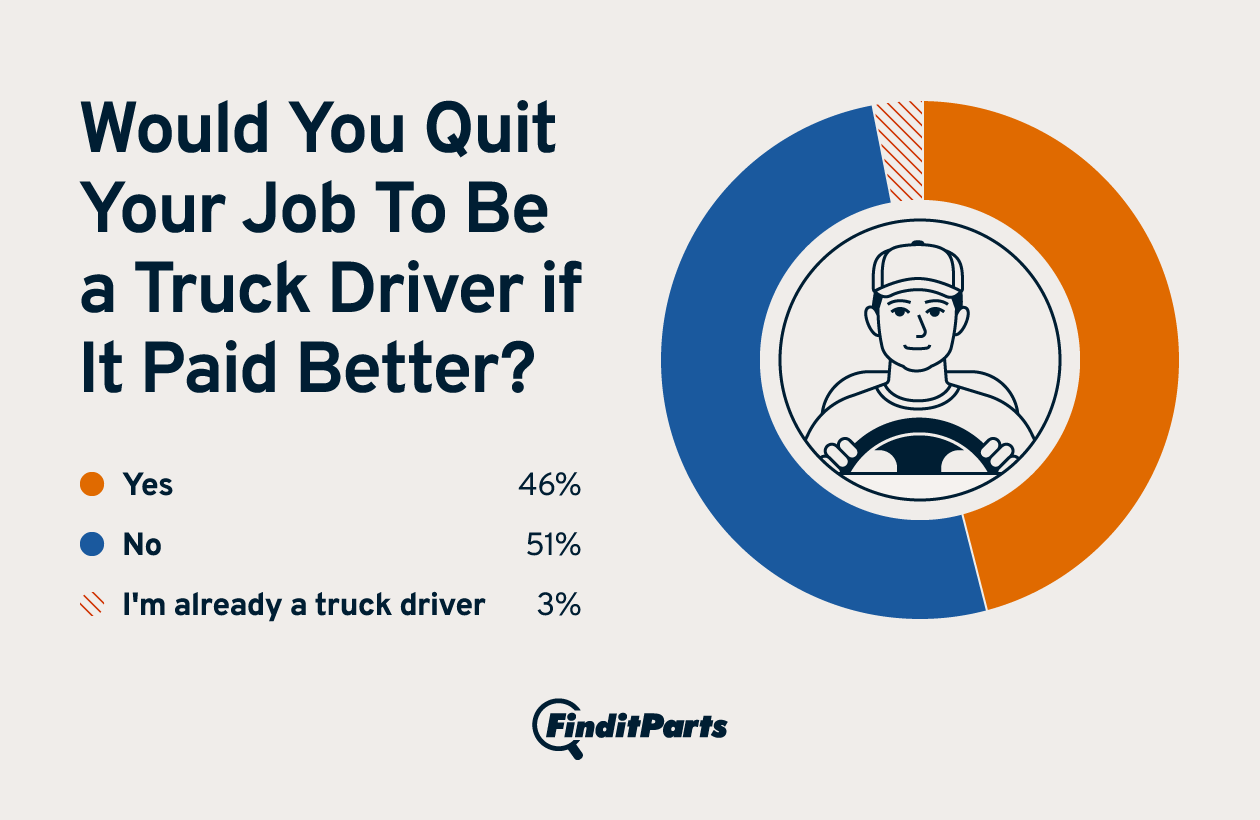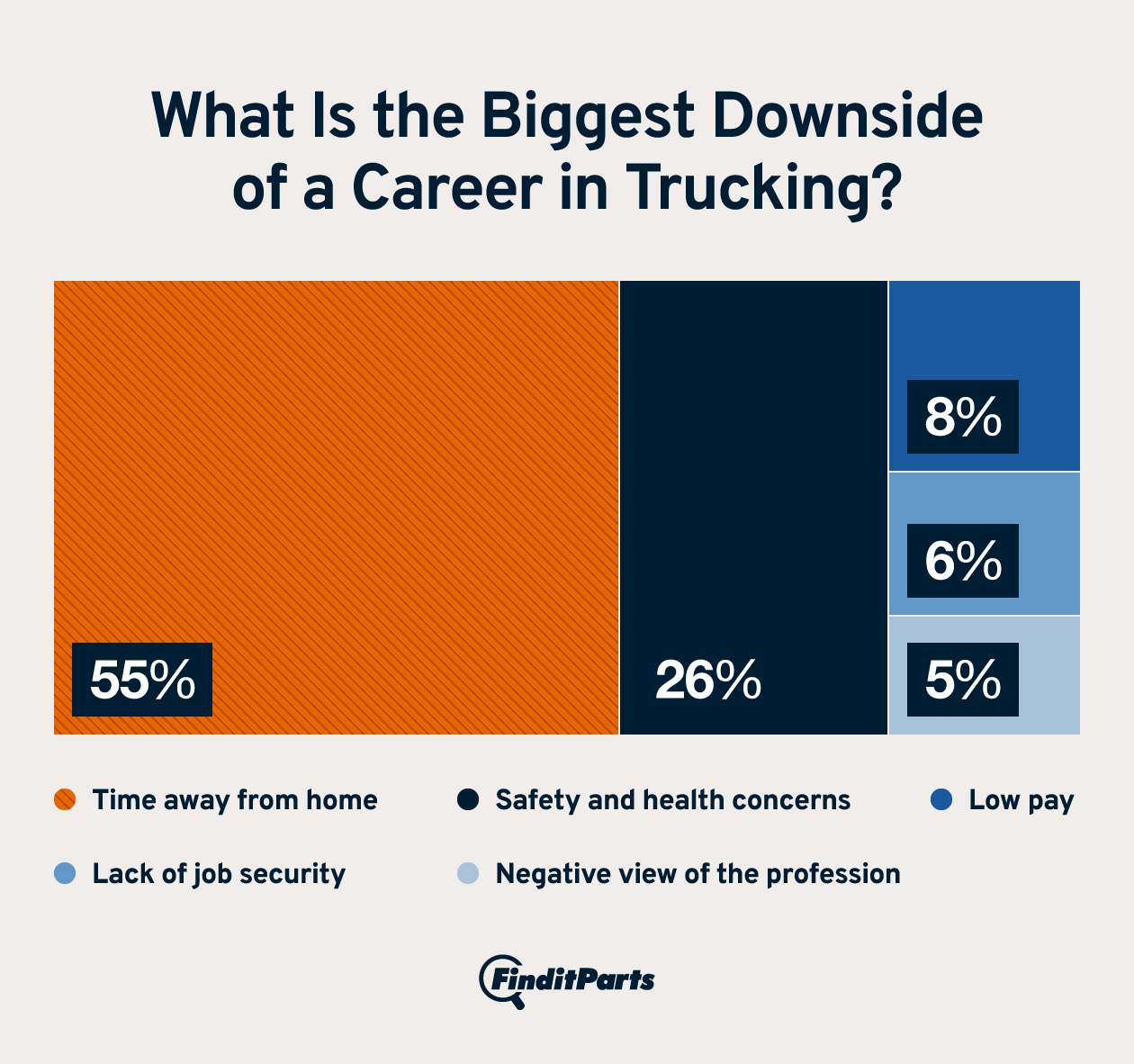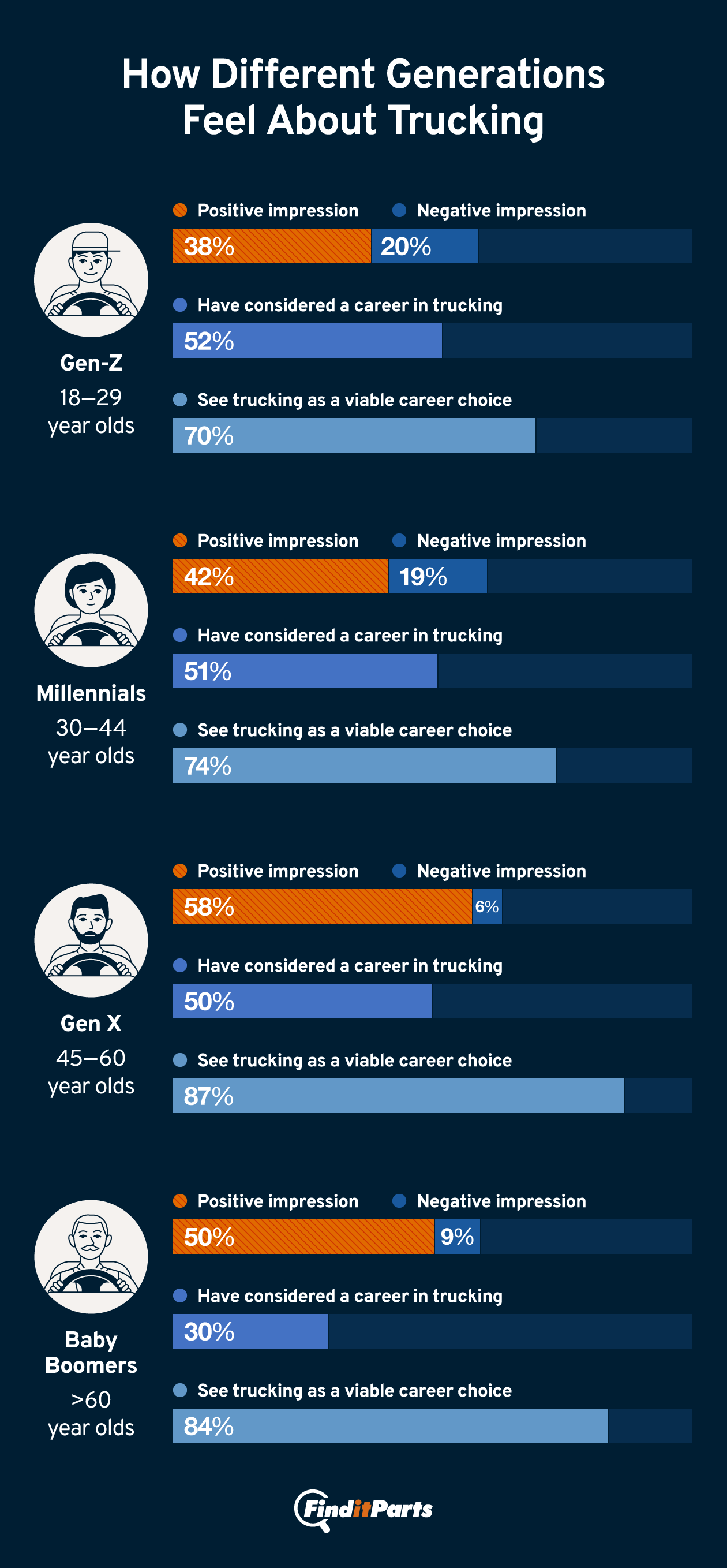Need help? We're here!
(888) 312-8812 Login SignupSURVEY: Nearly Half of Americans Would Trade Their Job for a Career in Trucking
February 13, 2025

It's no secret that the trucking industry is essential to the U.S. economy, so why do so few Americans land on truck driving as a career choice? To find out how people really feel about getting behind the wheel of a semi, we surveyed over 1,000 adults to learn what it would take to make them become a truck driver, what they think the biggest downsides of trucking are, and whether they believe it's still a viable career choice for young people today.
Key Takeaways:
- Roughly 45% of Americans have considered becoming a truck driver.
- Nearly 1 in 2 Americans would quit their job to drive a truck if it paid more than they make now.
- Americans think time away from home is the biggest downside to trucking.
- Nearly a quarter of Americans say they wouldn't become a truck driver no matter how much it paid.
- 62% of Americans believe truck drivers are paid too little for their work.
Nearly Half of Americans Say They’d Become a Truck Driver if It Paid More Than Their Current Job
Despite concerns about work-life balance for truckers, 46% of people admit they'd leave their current job to be a truck driver if it paid more than they make now. While that number would be different for everybody, 32% of respondents say they'd consider a career in trucking if it paid $100,000 or more a year.
This squares with our finding that 31% of Americans say the most important factors for whether they'd drive a semi-truck are pay and earning potential, compared to only 18% who say flexibility of schedule. But even if money is a strong incentive for most, nearly a quarter of Americans say they wouldn't become a truck driver no matter what salary they were offered.
Truck driver salaries can vary wildly depending on the city and state you operate out of, with averages ranging from $65,000 per year in Alaska to $48,000 per year in West Virginia. To earn $100,000 or more annually, you'd likely need to own and operate your own trucking business, which offers a median salary of over $180,000.
Realistically, even truckers with six-figure salaries have significantly lower take-home pay due to expenses like gas and maintenance, so new drivers hoping to bring in $100,000 a year may need to lower their expectations.
44% of Americans Have Considered Driving a Semi-Truck for a Living
Despite the fact that truck drivers make up only around 2% of the U.S. workforce, a whopping 44% of Americans say they've considered driving a semi-truck as a career. While this may not reflect the reality of a nation in the middle of a truck driver shortage, it does show that a significant number of people have at least contemplated getting behind the wheel of a semi-truck.
Overall, men (53%) are more likely to have thought about a career in trucking than women (35%), but this is a surprisingly small difference considering only 6% of all truck drivers in the U.S. are female.
Among age groups, Gen Zers (52%) are most likely to say they've thought about driving a semi-truck for a living, although millennials (50%) and Gen Xers (50%) aren't far behind. On the other hand, baby boomers are 20% less likely to say they've considered becoming a truck driver than every other age group.
Americans Are Concerned Truckers Spend Too Much Time Away From Home
Many Americans are interested in truck driving as a career, so why do so few actually earn a commercial driver's license (CDL) and start trucking? Put simply, most people think truck drivers have to spend too much time away from home.
Our survey found that more than 50% of Americans believe excessive time away from home is the biggest downside to hauling freight for a living. In comparison, only 26% of respondents selected safety and health concerns as the biggest downsides, while less than 10% selected low pay, job security, or negative views of the profession.
These findings suggest that most Americans associate trucking with long hours and poor work-life balance. And they're not wrong—long-haul truckers can spend two or more weeks at a time away from home, which means sleeping at truck stops and rest areas instead of their beds. This helps explain why Americans are more than twice as likely to say they'd consider local trucking roles with standard hours than long-haul trucking.
Most Americans Still Think Truck Driving Is a Viable Career Choice
Though not everyone wants to get behind the wheel themselves, nearly 79% of Americans think truck driving is a viable career choice for young people entering the workforce. However, there's a slight generational divide in how strongly this belief is held: While over 80% of Gen Xers and baby boomers see trucking as a good career option, only around 70% of Gen Zers and millennials say the same.
This gap may reflect younger generations' awareness of automation and its potential impact on the future of trucking. But the majority of Americans from every age group still view trucking as a stable career path, suggesting that many people do not think self-driving trucks will seriously impact job security in the freight industry.
Additionally, our survey found that nearly 85% of Americans believe truck drivers are very important to the U.S. economy. Although this number was smaller for Gen Zers (75%) and millennials (80%), the general public sees trucking as both a viable career and an economic necessity.
Younger Generations Are Less Likely To Have a Positive Impression of Trucking
A common thread in our findings is that the public thinks trucking is an important, valuable job, but most people aren't willing to do it. While pay and work-life balance play a role in this, we also discovered that only 47% of people have a positive view of truck driving as a career, while the rest of the public is split between having a neutral (40%) or negative view (13%).
Interestingly, women are more than 10% more likely than men to have a negative impression of trucking and around 7% less likely to have a positive impression. This is likely due in part to the fact that truck driving remains a male-dominated industry.
There's a discrepancy between age groups, too, with Gen Xers (58%) being the demographic with the most positive view of freight hauling as a career. In comparison, only 38% of Gen Zers hold a positive view, suggesting a generational shift in how trucking is perceived.
One reason for this may be that people think truckers—like teachers and nurses—are underpaid and overworked, despite being critical to our nation's infrastructure. Indeed, our findings reveal that 62% of Americans believe truck drivers are paid too little for their services. With better wages and a more stable work-life balance, the general impression of trucking as a career would likely improve.
6 Career Tips for Prospective Truck Drivers
If you're looking to become a truck driver, it's important to research the industry to determine which role is right for you. Here are some tips to guide you as you start your career:
- Research salary information: This may be a given, but studying truck driver salaries will give you the best idea of your earning potential based on your state or city and your desired role.
- Earn a commercial driver's license: You'll need to earn your CDL to operate any large commercial vehicle. There are different license classes for different types of vehicles, but each requires training and a skills test.
- Consider driving school: This goes hand in hand with earning a CDL, but you can enroll in a truck driving academy to streamline the training process.
- Build up your experience: If you want to land high-paying roles, you need to gain as much experience as possible. This could mean taking part-time local roles before moving to a long-haul carrier.
- Find the right company: Research a potential employer's reputation before you sign on. At the very least, read reviews of the company from other drivers.
- Look into specializations: Trucking specializations like hazmat, tanker, and flatbed can lead to expanded job opportunities and increased earning potential.
With the global truck driver shortage projected to double by 2028, it's more critical than ever that prospective truckers have access to resources and education about navigating the freight industry. Whether you're a veteran driver or just getting started, FinditParts has all the heavy-duty truck parts you need to be road-ready in 2025 and beyond.






